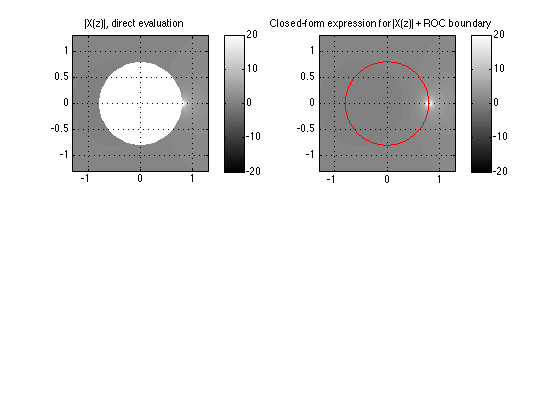Evaluating the Z transform numerically
An example of actually evaluating the Z transform for different values of Z, to show what happens when you leave the region of convergence.
2011-10-06,2013-10-02 Dan Ellis [email protected]
Here, we evaluate ![$X(z) = \sum_n x[n] z^{-n}$](eval_z_transf_eq23363.png) for an approximation to an indefinite-length sequence (the first 1000 points of an exponentially-decaying function) over a grid of
for an approximation to an indefinite-length sequence (the first 1000 points of an exponentially-decaying function) over a grid of  values; this clearly reveals the region of convergence, and the rapid explosion of the evaluated
values; this clearly reveals the region of convergence, and the rapid explosion of the evaluated  function when we leave the region of convergence. Of course, in this example, because we are evaluating only a finite range of n values, the function doesn't actually become infinite (although it does overflow even Matlab's 64 bit floating point representation in a few places), but it rapidly becomes so large that the trend is obvious.
function when we leave the region of convergence. Of course, in this example, because we are evaluating only a finite range of n values, the function doesn't actually become infinite (although it does overflow even Matlab's 64 bit floating point representation in a few places), but it rapidly becomes so large that the trend is obvious.
Let's look at the sequence ![$x[n] = \mu[n] \cdot \alpha^n$](eval_z_transf_eq24264.png) for
for  , and over the range
, and over the range  (1000 points)
(1000 points)
n = [0:999];
alpha = 0.8;
x = alpha.^n;
% By its 1000th point, x[n] has gotten quite small:
x(end)
ans = 1.5378e-97
For a given value of  , we can evaluate
, we can evaluate  by directly calculating the summation in the Z transform. This is the exact value of the Z transform for the finite-length
by directly calculating the summation in the Z transform. This is the exact value of the Z transform for the finite-length ![$x[n]$](eval_z_transf_eq17606.png) we are actually dealing with, but we can treat it as an approximation to the Z transform of the infinite-length
we are actually dealing with, but we can treat it as an approximation to the Z transform of the infinite-length ![$x[n] = \mu[n] \alpha^n$](eval_z_transf_eq00007.png) The closed-form Z-transform for this sequence is, of course,
The closed-form Z-transform for this sequence is, of course,  for
for 
z = 1.0; X = sum(x .* (z.^(-n))) % 5.0 % (We note in passing that $z = 1.0$ is also $z = e^{j\omega}$ for % $\omega = 0$, i.e. it is the zero-frequency value of the DTFT, and % hence also the zero-index term of the DFT. Check: Xf = fft(x); Xf(1) % 5.0 )
X =
5.0000
ans =
5.0000
OK, let's evaluate  not just for a single value of
not just for a single value of  , but for a uniform dense grid of values covering the
, but for a uniform dense grid of values covering the  -plane from -1.3 to 1.3 and from -1.3j to +1.3j
-plane from -1.3 to 1.3 and from -1.3j to +1.3j
incr = 0.01; zlim = 1.3; zvals = (-zlim):incr:zlim; for row = 1:length(zvals) for col = 1:length(zvals) z = zvals(col) + sqrt(-1)*zvals(row); X(row, col) = sum(x .* (z.^(-n))); % While we're here, also calculate the closed-form value of the % full (infinite)-length x, to compare Xc(row, col) = 1/(1 - alpha/z); end end % We're calcuating 260x260 ~= 70,000 values, so it make take a few % seconds % We now have a square array X(row,col) giving the values of our % Z transform every 0.01 over the range z values from -1.3 - j(1.3) % to 1.3 + j(1.3). % Some values close to (0,0) exceeded the numerical resolution and % ended up as NaNs. Let's just set these to Inf for consistency: X(isnan(X(:))) = Inf; % Plot the magnitudes as a grayscale image subplot(221) imagesc(zvals, zvals, abs(X)) axis xy; axis square; grid title('|X(z)|, direct evaluation') colormap('gray') colorbar % Matlab is trying hard to show us some very large values, with the % effect that nothing much is visible. Let's limit the color range % to some sensible values caxis([-20 20]) % Now we can see a boundary, and a little detail near the pole at % (0.8, 0). % Let's compare this to the closed-form results subplot(222) imagesc(zvals, zvals, abs(Xc)) axis xy; axis square; grid title('Closed-form expression for |X(z)| + ROC boundary') colorbar caxis([-20 20]) % overplot the ROC boundary at |z| = \alpha omega = [0:.01:2*pi]; hold on; plot(alpha*cos(omega), alpha*sin(omega), '-r'); hold off % We can now see that the closed-form equation does indeed give us % the right values for X(z), but only in the region of convergence % (the area outside the red circle).

The bottom line here is to illustrate the difference between the actual  calculated by literal application of the Z-transform definition, and the values given by the closed form solution (i.e., they match only in the ROC), and also to show that slightly surprising behavior of the Z-transform sum -- that
calculated by literal application of the Z-transform definition, and the values given by the closed form solution (i.e., they match only in the ROC), and also to show that slightly surprising behavior of the Z-transform sum -- that  abruptly explodes at the edge of the ROC defined by
abruptly explodes at the edge of the ROC defined by  -- really does happen that way, even for a finite-length approximation to an infinite causal sequence.
-- really does happen that way, even for a finite-length approximation to an infinite causal sequence.